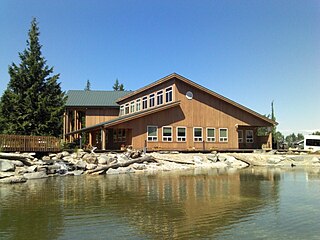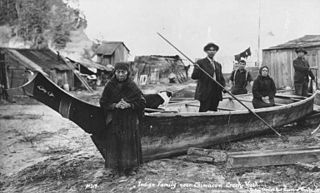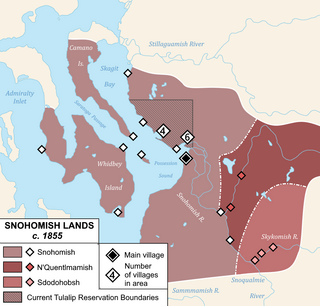Notes
- ↑ "Sahewamish". Four Directions Institute. Archived from the original on May 9, 2008. Retrieved 2007-10-05.
{{cite web}}: CS1 maint: unfit URL (link)
| Regions with significant populations | |
|---|---|
| United States (Washington) | |
| Languages | |
| English, Lushootseed | |
| Related ethnic groups | |
| other Salishan Twana peoples |
The Sahewamish are a Northwest Native American tribe of Lushootseed-speaking Coast Salish people. They were fisherman and hunter-gatherers, sedentary, and lived in the southwestern inlets of Puget Sound from Shelton, Washington, to the Nisqually River. There were about six villages. [1]
While some descendants of the tribe live on the Nisqually Reservation near Olympia, others live on the Squaxin Island Tribe reservation near Shelton.
In 1990, there were about 60 older adult speakers of the Sahewamish dialect, of the Salishan Lushootseed language.
{{cite web}}: CS1 maint: unfit URL (link)
The Muckleshoot are a Lushootseed-speaking Native American tribe, part of the Coast Salish peoples of the Pacific Northwest. They are descendants of the Duwamish peoples whose traditional territory was located along the Green and White rivers, including up to the headwaters in the foothills of the Cascade Mountains, in present-day Washington State. Since the mid-19th century, their reservation is located in the area of Auburn, Washington, about 15 miles (24 km) northeast of Tacoma and 35 miles (55 km) southeast of Seattle.

The Yakama are a Native American tribe with nearly 10,851 members, based primarily in eastern Washington state.

The Stillaguamish people are a Southern Coast Salish people Indigenous to the Stillaguamish River valley in northwestern Washington State in the United States, near the city of Arlington, Washington. The Stillaguamish speak Northern Lushootseed, a Coast Salish language. Although usage of the language has declined, there are ongoing revitalization efforts by the Stillaguamish Tribe.

The Squaxin Island Tribe are the descendants of several Lushootseed clans organized under the Squaxin Island Indian Reservation, a Native American tribal government in western Washington state.

The Puyallup Tribe of Indians is a federally-recognized tribe of Puyallup people from western Washington state, United States. The tribe is primarily located on the Puyallup Indian Reservation, although they also control off-reservation trust lands.
The Nisqually are a Lushootseed-speaking Native American tribe in western Washington state in the United States. They are a Southern Coast Salish people. They are federally recognized as the Nisqually Indian Tribe, formerly known as the Nisqually Indian Tribe of the Nisqually Reservation and the Confederated Tribes of the Chehalis Reservation.

The Suquamish are a Lushootseed-speaking Native American people, located in present-day Washington in the United States. They are a southern Coast Salish people.

The Duwamish are a Lushootseed-speaking Coast Salish people in western Washington, and the Indigenous people of metropolitan Seattle.
Sauk-Suiattle, or Sah-Ku-Me-Hu, is a federally recognized Native American tribe in western Washington state in the United States. The tribe historically lived along the banks of the Sauk, Suiattle, Cascade, Stillaguamish, and Skagit rivers, in the area known as Sauk Prairie at the foot of Whitehorse Mountain in the North Cascade Range.

The Klallampeople ; also Clallam, although the spelling with "K" is preferred in all four modern Klallam communities) are a Coast Salish people Indigenous to the northern Olympic Peninsula. The language of the Klallam is the Klallam language, a language closely related to the North Straits Salish languages. The Klallam are today citizens of four recognized bands: Three federally-recognized tribes in the United States and one band government in Canada. Two Klallam tribes, the Jamestown S'Klallam and Lower Elwha Klallam, live on the Olympic Peninsula, and one, the Port Gamble S'Klallam, on the Kitsap Peninsula in Washington state. In Canada, the Scia'new First Nation is based at Becher Bay on southern Vancouver Island in British Columbia.
Lushootseed, formerly known as Puget Salish, Puget Sound Salish, or Skagit-Nisqually, is a Central Coast Salish language of the Salishan language family. Lushootseed is the general name for the dialect continuum composed of two main dialects, Northern Lushootseed and Southern Lushootseed, which are further separated into smaller sub-dialects.

The Nisqually River is a river in west central Washington in the United States, approximately 81 miles (130 km) long. It drains part of the Cascade Range southeast of Tacoma, including the southern slope of Mount Rainier, and empties into the southern end of Puget Sound. Its outlet was designated in 1971 as the Nisqually Delta National Natural Landmark.

Chief Leschi was a chief of the Nisqually Indian Tribe of southern Puget Sound, Washington, primarily in the area of the Nisqually River.

The Snohomish people are a Lushootseed-speaking Southern Coast Salish people who are indigenous to the Puget Sound region of Washington State. Most Snohomish are enrolled in the Tulalip Tribes of Washington and reside on the reservation or nearby, although others are enrolled in other tribes, and some are members of the non-recognized Snohomish Tribe of Indians. Traditionally, the Snohomish occupied a wide area of land, including the Snohomish River, parts of Whidbey and Camano Islands, and the nearby coastline of Skagit Bay and Puget Sound. They had at least 25 permanent villages throughout their lands, but in 1855, signed the Treaty of Point Elliott and were relocated to the Tulalip Reservation. Although some moved to the reservation, the harsh conditions, lack of land, and oppressive policies of the United States government caused many to leave.
The Sammamish people are a Lushootseed-speaking Southern Coast Salish people. They are indigenous to the Sammamish River Valley in central King County, Washington. The Sammamish speak Lushootseed, a Coast Salish language which was historically spoken across most of Puget Sound, although its usage today is mostly reserved for cultural and ceremonial practices.
The region now known as Seattle has been inhabited since the end of the last glacial period. Archaeological excavations at West Point in Discovery Park, Magnolia confirm that the Seattle area has been inhabited by humans for at least 4,000 years and probably much longer. West Point was called Oka-dz-elt-cu, Per-co-dus-chule, or Pka-dzEltcu. The village of tohl-AHL-too had been inhabited at least since the 6th century CE, as had hah-AH-poos—"where there are horse clams"—at the then-mouth of the Duwamish River in what is now the Industrial District. The Lushootseed (Skagit-Nisqually)-speaking Salish Dkhw'Duw'Absh and Xacuabš —ancestors of today's Duwamish Tribe—occupied at least 17 villages in the mid-1850s and lived in some 93 permanent longhouses (khwaac'ál'al) along the lower Duwamish River, Elliott Bay, Salmon Bay, Portage Bay, Lake Washington, Lake Sammamish, and the Duwamish River tributaries, the Black and Cedar Rivers.

Chief Patkanim was chief of the Snoqualmoo (Snoqualmie) and Snohomish tribe in what is now modern Washington state.
The Nisqually Indian Tribe of the Nisqually Reservation is a federally recognized tribe of Nisqually people. They are a Coast Salish people of indigenous peoples of the Pacific Northwest. Their tribe is located in Washington.

The Snoqualmie people are a Lushootseed-speaking Southern Coast Salish people indigenous to the Snoqualmie Valley, located in east King and Snohomish counties in the state of Washington.